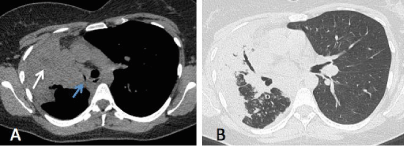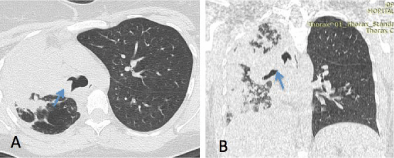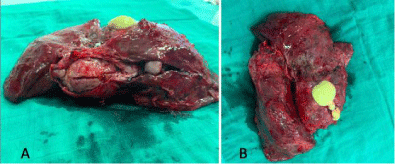
Case Report
Austin J Radiol. 2020; 7(3): 1115.
Pulmonary Sequestration and Carcinoid Tumor: An Unusual Association
Taibi B1*, Ayouche O1, Sabur S2, Moatassimbillah N1, Achir A2 and Nassar I1
¹Department of Radiology, Mohamed V University, Morocco
²Department of Thoracic Surgery, Mohamed V University, Morocco
*Corresponding author: Basma Taibi, Radiology Department, Ibn Sina Hospital, Mohamed V University, Rabat, Morocco
Received: October 09, 2020; Accepted: October 20, 2020; Published: October 27, 2020
Abstract
Introduction: Pulmonary Sequestration (PS) is an uncommon lung disease. Its association with carcinoid tumors is exceptional.
This case report presents a rare clinical case of carcinoid tumor in pulmonary sequestration. Imaging, has gained considerable momentum in the diagnosis and management of carcinoid tumors. Imaging techniques provide an accurate and comprehensive mapping of all lesions. These techniques are invaluable for initial diagnosis and follow-up treatment; they help to guide the therapeutic attitude and avoid later recurrence.
Case Report: We report a case of a 17-year-old woman with a bronchial carcinoid tumor arising from an intralobar bronchopulmonary sequestration. The vascular supply to the sequestered right lower lobe originated from the descending thoracic aorta. A pneumectomy was performed
Clinically, the patient presented recurrent episodes of pneumonia extending since her infancy, treated with antibiotics. She reported some episodes of hemoptysis as well. Nevertheless, no explorations were engaged until now. She was admitted to our unit, for tuberculosis suspicion.
Biological exploration revealed negative cytobacteriological arguments in favor of tuberculosis.
Regenerative anemia: Hb 10g/dl, VGM = 80fL, CCMH = 32g/dl, with reticulocytes >150G/L.
Acute kidney failure: creatinemia =100mg/L.
CT revealed a cystic low-density mass in the middle lung field, as well as cystic bronchiectasis in the right lower lobe. An endobronchial nodule was observed in the intermediary trunk, which was tough of as the primary cause of obstructive pneumonia.
A right lower lobectomy was performed. In the surgery, abnormal vessel growth from the mass was found.
Therefore, intralobar PS was diagnosed and pathological examination supported the diagnosis. Subsequently, pathological examination identified a carcinoid tumor let in the PS.
The findings of the pathological examination revealed a typical carcinoid tumor with pulmonary sequestration.
At the 6months follow-up examination, no complication was observed.
Conclusion: This report presents a rare clinical case of pulmonary sequestration as well as carcinoid tumor. When an endobronchial nodule is found in the lung of patients with recurrent pneumonia resistant to antibiotics. Neoplastic etiologies should be considered; followed by diagnostic imaging procedures as well as prompt surgical removal.
Keywords: Pulmonary sequestration; Carcinoid tumor; Bronchiectasis; Obstructive pneumonia; CT
Introduction
Pulmonary Sequestration (PS) is an uncommon congenital disease defined as a segment of lung parenchyma separated from the tracheobronchial tree and receiving its blood supply from a systemic artery rather than a pulmonary arterial branch [1].
Pulmonary carcinoid tumors is a nodular proliferation of neuroendocrine cells [2,3].
This report presents a rare clinical case of carcinoid tumors in pulmonary sequestration with bronchiectasis.
Case Report
We report a case of a 17-year-old woman with a bronchial carcinoid tumor arising from an intralobar bronchopulmonary sequestration. She was a nonsmoker and did not have any other disease or a family history of any disease.
Clinically, the patient presented reccurent episodes of pneumonia extending since her infancy, treated with antibiotics. She reported some episodes of hemoptysis as well. Nevertheless no explorations were engaged until now due to medical negligence. She was admitted in our unit, for tuberculosis suspicion.
Biological exploration revealed negative cytobacteriological arguments in favor of tuberculosis.
Regenerative anemia: Hb 10g/dl, VGM = 80fL, CCMH = 32g/dl, with reticulocytes >150G/L.
Chest radiography showed a middle lobe mass with cystic bronchiectasis which was thought of as obstructive pneumonia.
CT revealed a cystic low-density mass in the middle lung field, as well as cystic bronchiectasis in the right lower lobe (Figure 1). An endobronchial nodule was observed in the intermediary trunk (Figure 2), which was tough of as the primary cause of obstructive pneumonia.

Figure 1: Axial computed tomography scan at the level of the right mainstem
bronchus (A) demonstrating the presence of a cystic low-density mass (wight
arrow) in the middle lung field with an endobronchial nodule (blue arrow) as
well as cystic bronchiectasis in the right lower lobe(B)

Figure 2: Axial computed tomography scan at the level of the right mainstem
bronchus (A) with coronal reconstruction (B) demonstrating the presence of
an occluding intraluminal mass (arrow) with apparent distal consolidation
or collapse subsequently shown to be an intralobar sequestration following
review of the resected specimen.
After the infection was controlled, a posterolateral thoracotomy with single-lung ventilation was performed through the fifth intercostal space, sparing the serratus anterior muscle.
This procedure was performed under general anesthesia, with the patient lying in the right lateral position. A necrotic mass was located in the middle lobe, and feeding arteries from the descending aorta were observed. There was also a yellow nodular lesion spanning on the right intermediate bronchial trunk that was considered as a process (Figure 3). After ligation and division of the feeding arteries, a standard right lower lobectomy was performed.

Figure 3: A macroscopic view of the specimen showing the necrotic mass
of the middle lobe (A) with a yellow nodular lesion spanning on the right
intermediate bronchial trunk which turns out to be a carcinoid tumor.
The findings of the pathological examination revealed a typical carcinoid tumor with pulmonary sequestration.
The patient was discharged on the tenth postoperative day without any complications.
At the 6months follow-up examination, no complication was observed and tumor recurrence or distant metastasis was detected on Positron Emission Tomography (PET/CT).
Discussion
Pulmonary sequestration is a rare congenital malformation; defined as a segment or lobe of the lung that has no bronchial communication with the normal tracheobronchial tree It is more common in the left lung and lower lobes [4].
Anatomically, it has been described in two different forms: intra lobar and extra lobar. Intra lobar pulmonary sequestration, which comprises 75% of all PS, the abnormal tissue is surrounded by normal lung, so it shares the same pleura as normal lung tissue. while the extra lobar form is separated from normal lung tissue with its own pleura and maintains complete anatomical and physiological separation between the cyst and the adjacent normal lung [5].
In the case presented here, the lung parenchyma was found to share the same pleura with normal lung tissue, and is therefore the intra lobar type.
It has also been claimed that intra lobar sequestration may arise as an acquired lesion, possibly secondary to local infection, such as bronchiectasis [6,7].
Patients with ILS frequently show signs of respiratory tract infection, whereas those with ELS are generally asymptomatic [2].
Intralobar pulmonary sequestration with a carcinoid tumor has rarely been reported in the literature. First described by Juettner et al. who report an association between carcinoid tumor and intra lobar sequestration.
Carcinoid tumorlet is a nodular proliferation of neuroendocrine cells and arises from focal areas of bronchial and bronchiolar Kultschitsky cells, usually associated with diffuse bronchiectasis and intralobar sequestration [7–10].
D’Agati and Perzin found that pulmonary tumor-lets had tumor characteristics since they could metastasize to the lymph nodes [11].
Chromogranin A, CD56 and synaptophysin are the most useful neuroendocrine immunohistochemical markers, and low levels of Ki-67 can help to distinguish neuroendocrine from small-cell carcinoma. In the present case the nodule was 0.4 cm, and positive for synaptophysin, chromogranin A, CK-L, Ki-67 (<1% positive), TIF1 and CD56, and negative for S-100, so carcinoid tumorlet was diagnosed.
Pulmonary carcinoid tumors are neoplasms of neuroendocrine origin.
They account for approximately 25~30% of all carcinoid tumors and approximately 3% of all bronchopulmonary neoplasms [1].
Certain studies claim that carcinoid tumor may be induced by hypoxia caused by bronchiectasis or other chronic bronchitis lesions.
In the case studied by Eustace et al. (1996), the carcinoid tumor occluded the airway proximal to the sequestered segment, resulting in distal stasis and thereby creating a potential site for chronic infection; these findings suggest that the carcinoid tumor caused the sequestration [7].
In our case, the patient had a medical history of long-term inflammation in the form of recurrent pneumonia that persisted for several years. The carcinoid tumor in our patient did not occlude the airway, and therefore, the tumor probably did not cause the inflammation.
We assume that the carcinoid tumor was a complication of the intralobar pulmonary sequestration. However, to date, the etiology of the intralobar sequestration in association with the carcinoid tumor remains disputed.
Patients with pulmonary sequestration are frequently treated for benign diseases such as pneumonia. If the symptoms of patients with pulmonary sequestration are not serious, the condition may not warrant intervention and thus persist for several years.
However, as previously mentioned, carcinoid tumors are lowgrade malignancies. Without treatment, a carcinoid tumor with sequestration can worsen a patient’s condition and spread to other organs.
Patients with intralobar pulmonary sequestration and carcinoid tumors should receive regular follow-up examinations after treatment to detect recurrence or metastasis of carcinoid tumors.
Further studies are required to investigate the pathogenesis of carcinoid tumors associated with pulmonary sequestration.
Conclusion
This report presents a rare clinical case of pulmonary sequestration as well as carcinoid tumor. When an endobronchial nodule is found in the lung of patients with recurrent pneumonia resistant to antibiotics. Neoplastic etiologies should be considered; followed by diagnostic imaging procedures as well as prompt surgical removal.
References
- Corbett HJ, Humphrey GM. Pulmonary sequestration. Paediatric respiratory reviews. 2004; 5: 59-68.
- Koo CW, Baliff JP, Torigian DA, Litzky LA, Gefter WB, Akers SR. Spectrum of pulmonary neuroendocrine cell proliferation: diffuse idiopathic pulmonary neuroendocrine cell hyperplasia, tumorlet, and carcinoids. American Journal of Roentgenology. 2010; 195: 661-668.
- Savic B, Birtel F, Tholen W, Funke H, Knoche R. Lung sequestration: report of seven cases and review of 540 published cases. Thorax. 1979; 34: 96-101.
- Stocker JT, editor Sequestrations of the lung. Seminars in diagnostic pathology; 1986.
- Beasley MB. The 2004 World Health Organization classification of lung tumors. Semin Roentgenol. 2005; 40: 90-97.
- Dewan M, Malatani T, Osinowo O, Al-Nour M, Zahrani M. Lessons to be learned: a case study approach Carcinoid tumourlets associated with diffuse bronchiectasis and intralobar sequestration. The journal of the Royal Society for the Promotion of Health. 2000; 120: 192-195.
- D’Agati VD, Perzin KH. Carcinoid tumorlets of the lung with metastasis to a peribronchial lymph node. Report of a case and review of the literature. Cancer. 1985; 55: 2472-2476.
- Travis W. Advances in neuroendocrine lung tumors. Annals of Oncology. 2010; 21: 65-71.
- Ma DS, Kim SA, Kim HR, Kim YH, Park SI, Kim DK. Bronchial carcinoid tumor arising from an intralobar bronchopulmonary sequestration. The Korean journal of thoracic and cardiovascular surgery. 2011; 44: 444.
- Resl M, Král B, Simek J. Carcinoid tumorlets and pulmonary hypoxia. Ceskoslovenska patologie. 1995; 31: 84-86.
- Eustace S, Valentine S, Murray J. Acquired intralobar bronchopulmonary sequestration secondary to occluding endobronchial carcinoid tumor. Clinical imaging. 1996; 20: 178-180.